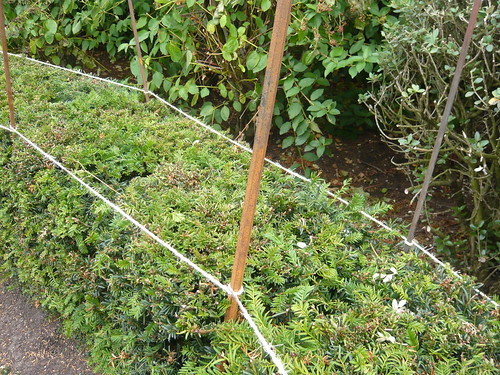Trim a Straight and Floral Hedge

August is a good time to trim your hedges and create a neat appearance for autumn and winter.
When of Hedge Trimming.
- When birds have flown their nests you can trim to your hearts content without disturbing the fledglings.
- Try to prune a wild life hedge only after the fruit have been eaten in late winter.
- Trimming in late summer leaves enough time for hedges to to put on a bit of new growth to cover ravaged twigs.
- Do not trim conifers later than August as they may go brown and unsightly.
- Prune flowering hedges straight after flowering.
The How of Hedge Trimming
- To achieve a flat top stretch taught string to provide a horizontal plumb line.
- To make a bend in the hedge use double stakes with the string as in the photograph.
- Trim a hedge from the bottom upwards so trimmings fall away.
- Use secateurs to tidy up after trimmers if they leave a mess.
- Beech, Privet, Holly and Hawthorn all recover from hard pruning. Conifers will not regrow from brown wood.
Flowering Hedges
- Camellia will form an evergreen barrier.
- Forsythia has brilliant yellow flowers in spring but works best in a mixed hedge.
- Berberis creates a dense, thorny hedge with spring flowers and autumn berries. Deciduous and evergreen varieties are available.
- Upright hardy varieties of Fuchsia can look good in a warm garden.
- Lavender’s fragrant flowers add to an informal low hedge.
- Informal hedges of large leaved Laurel are often found in old gardens
One thought on “Trim a Straight and Floral Hedge”
These are great tips! I wouldn’t have known. Thanks!
Comments are closed.